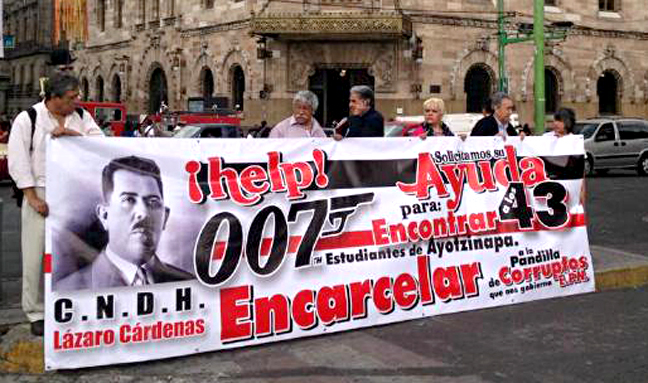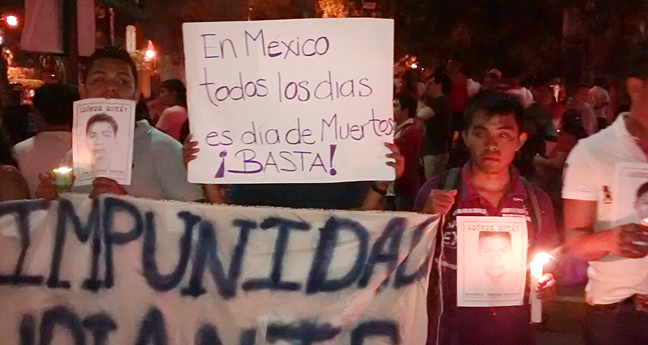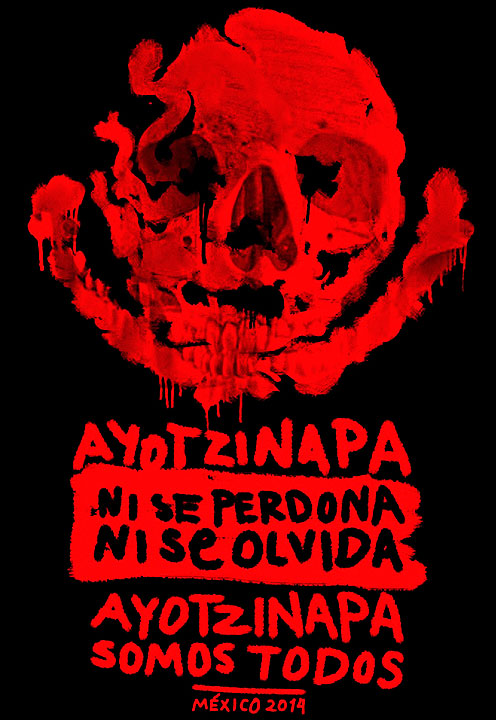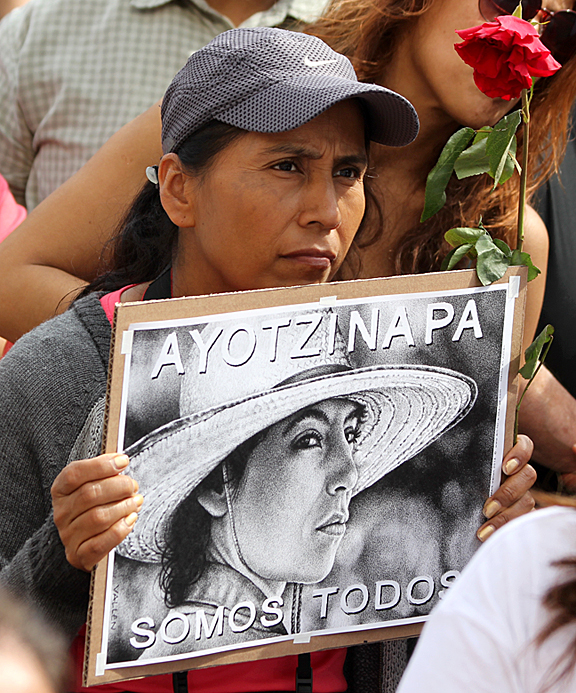007: The Spectre of Ayotzinapa

Four minutes of dazzling footage comprises the eye-popping, jaw dropping opening sequence of Spectre, the latest James Bond film. In the first scene, James Bond (played by actor Daniel Craig), is seen walking through a Día de los Muertos procession in Mexico City wearing a skull mask. He sports a Top Hat as befitting a bourgeois Mexican gentleman of the early 1900s. Strolling with 007 is “Bond Girl” Estrella (played by Mexican actress Stephanie Sigman), who wears a painted mask of La Calavera Catrina, an iconic female figure from historic Day of the Dead celebrations.

The dapper two weave their way through a huge crowd of people dressed as skeletons and carrying giant skeleton puppets; they all make their way to the capital’s main square, the Zócalo. Bond spots the villain Marco Sciarra and a fight ensues. To rescue their boss from Bond, Sciarra’s henchmen land a helicopter in the Zócalo, but when Sciarra hops on, so does 007. A desperate onboard fight takes place as the chopper soars over the modern skyline of Mexico City in a death defying display of flying.
Spectre is a perfect example of film being used to influence public opinion for political reasons. How so? Apparently the government of Mexican President Enrique Peña Nieto and his Institutional Revolutionary Party (PRI) paid MGM studios millions of dollars for the scene described above; the studio accepted the money in order to bring production costs down. A collaborative effort, the Mexican government wanted positive “spin” to improve its deplorable human rights record, and MGM wanted tax breaks. I will address this government-studio deal in the second half of this essay, but first, some background.

Let us not forget that in the Mexican state of Guerrero, 43 students from the Ayotzinapa Rural Teachers’ Collage were assaulted and kidnapped by the police on the night of September 26, 2014. While in the act of kidnapping the 43, the police shot and killed three bystanders and three other Ayotzinapa students. One of them, the 22-year old Julio César Mondragón, was found dead on the street the next day; his eyes had been gouged out and the skin peeled from his face. Recall that in the official government version of the story, the police turned their 43 captives over to the criminal drug gang Guerreros Unidos (United Warriors) to be tortured, killed, and incinerated in a huge bonfire at a garbage dump; their ashes allegedly put in plastic bags and dumped in the San Juan River. Remember that millions of Mexicans marched in the streets to protest these outrages with a slogan that identified the guilty – Fue el estado (“It was the state”).
The production designer for Spectre, Dennis Gassner, told the press that producing and filming the Dia de los Muertos opening sequence was “a magical experience.” He went on to say: “This culture is saying something here. This is a statement about their world and how they want the rest of the world to see it. This is a format that the world can see it in, that’s what all these people are doing. They’re passionate about what they want to do and they want to share it with the world. They want to show people that they should come to Mexico” [1].
The creative individuals involved in the making of Spectre may talk about the movie’s opening sequence as a “magical experience,” but their eyes are tightly closed to the truth.
Yes, there certainly are those who work to present “how they want the rest of the world to see” Mexico, but in the case of Spectre, it is not the Mexican people but the crooked regime of Enrique Peña Nieto and the PRI that plotted and colluded with Hollywood. Mr. Nieto was “elected” president on July 1, 2012 through massive fraud. The PRI bought votes as well as positive press from the country’s dominant TV networks. Even before Mexico’s official election results were in, President Obama called Nieto to congratulate him on his electoral “victory,” and to applaud Mexico’s “free, fair, and transparent election process” [2].
At the time Mr. Peña Nieto’s most shameful scam was the distribution of pre-paid gift cards for the Soriana supermarket chain; each card was worth 500 pesos ($37.50) and was to be used in purchasing food. Some $8.2 million dollars worth of the cards were distributed. In Mexico City the average worker’s daily wage is just 67 pesos ($5.12). No friend to working people, the World Bank reported that 52.3% of the Mexican people lived in poverty in 2012 when Peña Nieto’s election took place [3]. Right after the fraudulent election, tens of thousands of people swarmed Soriana markets to find their gift cards were not valid, or worth only a few dollars!
Approximately four months after the kidnapping of the Ayotzinapa 43, the Mexican government announced it had “officially” concluded that the students were dead. The phony investigation had been conducted by Jesús Murillo Karam, a functionary of the PRI and President Peña Nieto’s attorney general. At a Jan. 27, 2015 press conference given by Karam, he stated that government “interrogation” of detained suspects provided “legal certainty that the student teachers were killed.” Karam offered no conclusive evidence to back up his claim, but stood firm in avowing that the government findings were the “historic truth.” He repeated that federal forces were in no way involved with the kidnapping. On the heels of Karam’s press conference, President Peña Nieto urged Mexicans to accept the government’s conclusion, saying: “We have to move forward with greater optimism.” The words of Mr. Nieto and his attorney general were utterly worthless.
The day after the government press conference, José Miguel Vivanco, the director of the Americas division of Human Rights Watch, denounced Karam’s findings, calling the government’s investigations “negligent” and “difficult to trust,” given that confessions are “based on coercion, torture, and irregularities.” Vivanco said the government claim “is not a historical truth, it is an official version” [4].
Needless to say, the parents, families, and relatives of the missing 43 were infuriated with the administration of Mr. Nieto for closing the case. Taking to the streets to denounce the government’s sham investigations, thousands marched in Mexico City chanting, “¡Vivos se los llevaron, vivos los queremos!” (They took them alive, we want them alive!)

It is ironic that Spectre opens with a Day of the Dead procession, and that “Bond Girl” Estrella has her face painted as La Calavera Catrina, but the irony is no doubt lost on the film’s producers. José Guadalupe Posada (1852-1913) was one of Mexico’s greatest artists and acknowledged as the founder of Mexican printmaking. He was inspired by the aesthetics of the Aztecs, who created skeletonized depictions of supernatural beings in their art. Posada made prints of skeletons dressed as ordinary people, as well as priests, politicians, generals, and oligarchs, offering a mocking social criticism that continues to influence Mexican art and culture.
Around 1910 Posada created the etching Calavera Garbancera (Garbancera Skull). Living under the dictatorship of Porfirio Díaz, Mexico was on the verge of revolution.
Posada published his print as a critique of the “Garbanceras,” those people with indigenous blood who renounced their race and culture to pass themselves off as Spanish or French. The etching depicted an indigenous woman as a skeleton, poor and naked, whose fancy European-style hat was her only claim to being European. In 1946 Diego Rivera began painting his mural, Dream of a Sunday Afternoon in the Alameda Central. An admirer of Posada, Rivera’s mural included a portrait of Posada arm in arm with his Calavera Garbancera dressed in Victorian clothes. Rivera christened his version of the female skeleton, La Calavera Catrina, and the Catrina has today become an iconic image for the Day of the Dead. However, the original critique behind Posada’s print is still pertinent today.
The filming for the opening sequence of Spectre began in Mexico on March 19, 2015. The ten-day film shoot received considerable attention in the mainstream media, but outside of Mexico the press left out the following important fact. On March 21 a group of pro-democracy activists gathered near the film shoot and held up a satiric banner emblazoned with the 007 logo, it read: “Help! 007, we request your help finding the 43 students of Ayotzinapa. Imprison the corrupt EPN gang that governs us.” The EPN abbreviation of course stands for Enrique Peña Nieto. The sign was the creation of the National Human Rights Commission (C.N.D.H.), the non-governmental human rights organization of Mexico that is accredited by the United Nations.

One protester told the press: “It is a total irony and mockery of the system of government that the Mexican people would have to ask for help from our misfortunes from the largest representative of world imperialism, James Bond. Since you are here, save us from all the misfortunes of our people because of the corruption and impunity of the government.”
Regarding the comments made by Spectre production designer Mr. Gassner, that the Mexican people were “saying something” about their culture in the film’s Day of the Dead sequence. If you want to know how Mexicanos actually marked Dia de los Muertos in Nov. 2014, consider the following. Thousands of University students in Yucatan, Mexico held a candlelight march that evening to protest the disappearance of the 43 Ayotzinapa students. Signs were held that read: “In Mexico, everyday is Day of the Dead.” Similar marches and rituals were held all across Mexico that day involving hundreds of thousands of people.

The details of the hush-hush agreement between the Mexican government and MGM regarding Spectre, and how those secrets became public, reads like a script from a James Bond thriller.
As many readers are probably aware, on November 24, 2014, a hacker or hackers broke into the computer system of Sony Pictures Entertainment, leaving a flashing message on every computer controlled by Sony Pictures. It read: “We’ve obtained all your internal data, including your secrets and top secrets.” The cyber-criminals warned that if their demands were not met, the stolen data would be released to the public. What they supposedly wanted was for Sony to block release of The Interview, a Hollywood comedy directed by Seth Rogen and Evan Goldberg about two celebrity American journalists recruited by the CIA to assassinate the dictator of North Korea, Kim Jong-un.
At first Sony put The Interview on hold, but then reversed its decision and screened the film nationwide. The hackers made good on their threat and began to dump some 100 terabytes of sensitive information into the hands of the media, an estimated 38 million files. That info included the scandalous private e-mails and internal communications of top Sony and MGM executives. Sony and the FBI accused the North Korean government of being responsible for the hacking, but that is another story.
What is relevant to this article is that the script for Spectre was stolen in the cyber-attack and released to the media. E-mail exchanges between Sony and MGM officials were also leaked, and they revealed what the executives referred to as the “Mexican Deal.” One of the leaked communications included remarks from the president of MGM’s motion picture group Jonathan Glickman, who wrote the following regarding the deal:
“We are currently facing a budget that is far beyond what we anticipated and are under immense pressure to reduce the number to $250M net of rebates and incentives. This is not about ‘nickel and diming’ the production. As of now, our shooting period is $50M higher than Skyfall and the current gross budget sits in the mid $300Ms, making this one of the most expensive films ever made.”
According to a March 3, 2015 story published by Tax Analysts, the Mexican government proposed a lucrative deal with MGM; they offered to give the studio $20 million dollars worth of tax breaks and other incentives, if the studio allowed the Mexican government to change the cast and make significant alterations to the film’s story. A reading of Sony’s leaked e-mails indicates that the deal went through. In a memo titled, “Elements needed to preserve Mexican deal,” [5] Mr. Glickman listed the specific changes the Mexican government wanted from MGM:
Cast “a known Mexican actress” as Estrella, the Bond girl that appears in the opening sequence whose hotel room is the starting point for Bond’s search for villain Marco Sciarra. MGM gave the part to Mexican-born Stephanie Sigman.
Sciarra, the villainous character and adversary of James Bond at the beginning of the film, could not be a Mexican, or be played by a Mexican. MGM cast the Italian actor Alessandro Cremona to play the assassin, and rewrote the Sciarra character to be Italian.
A cage match duel between Marco Sciarra and Bond needed to be replaced by Bond chasing after Sciarra through a Day of the Dead procession.
Lucia Sciarra, widow of slain gangster Marco Sciarra and the chief villain of the film, also could not be a Mexican, or be played by a Mexican. MGM cast the Italian actress Monica Bellucci to play the Italian nemesis.
“Modern Mexico City buildings” had to appear in the movie’s aerial shots instead of Mexico’s notorious slums. MGM met that demand with the helicopter soaring over the skyline of Mexico City in the movie’s opening scene.
Rather than have Lucia Sciarra order the assassination of a Mexican governor, the victim had to be an international ambassador.
The November 24, 2014, cyber attack on Sony Pictures Entertainment occurred approximately two months after the kidnapping of the Ayotzinapa 43. The leaked documents reveal that MGM was already in the midst of altering Spectre to meet the demands of the Mexican government, that is, before the kidnappings. Be that as it may, the film’s opening scenes in essence serve as a cover for the shameless corruption and contemptible human rights record of Mexico’s government.
Mexico’s drug war has taken the lives of over 100,000 people since 2006, and since President Peña Nieto took office in 2012, an additional 10,000 people have been “disappeared” by drug gangs or state forces. Are they not sometimes one and the same? Most of those cases remain unsolved. There have been 81 cases of human rights activists being disappeared and presumably murdered during Peña Nieto’s administration. Some 41 journalists have been assassinated since 2010, most of them on Mr. Nieto’s watch, bringing even the New York Times to write an Aug. 15, 2015 editorial statement titled, The Murder of Mexico’s Free Press. On the same day, PEN America published a letter signed by over 500 international artists, journalists, writers, and free expression advocates. Addressed to President Peña Nieto, the letter said in part:
“PEN and the Committee to Protect Journalists (CPJ), would like to express our indignation regarding the deadly attacks against reporters in your country. An attempt on the life of a journalist is an attack on society’s very right to be informed.”
Suffice it to say, the PEN letter was not signed by anyone associated with the creation of Spectre.
In the present context, with September 26, 2015 marking the one year anniversary of the Ayotzinapa 43 being kidnapped, the premiere of Spectre in theaters November 6th, 2015 serves to whitewash the evil done to the Mexican people. There are plenty of corrupt characters portrayed in Spectre, but none so corrupt as those described in this essay.

As I was finishing up this article, the results of a six-month long investigation into the kidnapping of the Ayotzinapa 43 were published on Sept. 6, 2015.
The Inter-American Commission on Human Rights (IACHR) of the Organization of American States (OAS), appointed an independent investigatory body called the Grupo Interdisciplinario de Expertos Independientes (GIEI), composed of five human rights experts.
The 560-page report from the GIEI could hardly be more condemnatory of the Peña Nieto administration. Jose Miguel Vivanco of Human Rights Watch called it “an utterly damning indictment of Mexico’s handling of the worst human rights atrocity in recent memory.”
The GIEI report forcefully rejects the Mexican government’s version of events. The report acknowledges that the students had commandeered four buses to take them to a commemorative event in Mexico City marking the 46th anniversary of the 1968 Tlatelolco massacre. It also found that the police and military had tracked the students from the moment they left their school in Ayotzinapa at six pm, to when they were attacked by police after midnight in the city of Iguala, in the southern Mexican state of Guerrero. Police and military units sent communications to their forces on the student’s movements, and those reports were routed to C4, Mexico City’s Control, Command, Communication and Computer intelligence network, the most sophisticated security system in all of Latin America. In other words, federal authorities in Mexico City were monitoring the events from beginning to end in real time.
The GIEI said that when municipal, state, and federal police stopped the buses after midnight, soldiers from the Mexican Army’s 27th Infantry Battalion observed the police assaulting and detaining the students; contradicting the government’s assertion that no federal forces were involved in the kidnapping. The role of the federal police and the army remains unclear, but what is absolutely clear is that neither intervened to stop the shooting and kidnapping of the students. During the GIEI’s investigation, the Peña Nieto administration refused to allow the group to interview Mexican soldiers.
The official government report on the kidnapping mentioned only four buses used by the students, but the GIEI report confirmed through video evidence that the students had commandeered a fifth bus. The GIEI uncovered a still from a security camera at the bus terminal in Iguala where the students seized the bus; the photo not only showed the fifth bus, it showed the student passengers onboard. This photo was never included in the government investigation, though surviving students always maintained that five buses were involved. The government then changed its story, saying the students seized the bus, but due to mechanical failure, returned it to the terminal. When the GIEI asked the government to show them bus number five, they were shown a bus that bore a number of dissimilarities to the one from the security camera photo; leading to the conclusion that the fifth bus is now missing.

Most importantly, the GIEI believes that the police attacks on the buses were not meant to stop the students, they were meant to seize the fifth bus, because the students had unknowingly seized a bus that the Guerreros Unidos drug cartel was using to transport heroin to the United States.
What is being described here is an illegal conspiracy between corrupt government authorities and drug cartels in sharing control of Mexico’s profitable heroin trade – with annual profits registering in the billions. According to the U.S. Drug Enforcement Administration, nearly half of the heroin found in the U.S. in 2014 came from poppies grown in Mexico.
It is a fact that Guerreros Unidos have been shipping heroin to the United States. In Dec. 2014 U.S. federal authorities in Chicago arrested members of the Guerreros Unidos cartel for shipping heroin concealed “in commercial passenger buses that traveled from Mexico to Chicago.” [6]
One must ask why the Peña Nieto regime never investigated the possibility that the Ayotzinapa students paid with their lives for inadvertently interrupting a cartel heroin smuggling operation.
The GIEI report stated there was no evidence to support the government’s story that Guerreros Unidos had incinerated the dead students. The GIEI report noted that at least 500 cords of wood, or 100 tons of tires would have been necessary to create a fire large enough to turn the victims to ashes, but these materials were not available at the garbage dump where the cremation allegedly occurred. Moreover, to incinerate the bodies the fire would have needed to burn for 60 hours, yet the government contends it burned for only 16 hours. The government also claimed that Guerreros Unidos members stayed near the fire to keep it stoked, but the GIEI report stated that a fire large enough to incinerate 43 bodies would have burned to death anyone standing within 900 feet of it. Additionally, the land and vegetation at the dump was not scorched, and there was no evidence of a massive fire.
The GIEI report stated that during its investigation, the Mexican government committed grievous errors, made omissions and false conclusions, obstructed justice, used torture, cover-ups, and threats against surviving students, and ignored and destroyed evidence. For instance, CCTV camera footage made on the evening of the kidnapping had been deleted from government databases. As for the complete C4 records of police and army communications made on Sept. 26th, 2014… not surprisingly, they are “missing.”
It should be remembered that in 2014 President Obama boosted U.S. military aid to Mexico to $15 million a year, and that Mr. Obama continues to approve the bilateral Mérida Initiative with Mexico that funds the Mexican security apparatus to the tune of $2.5 billion Yankee dollars. [7] But the tyranny in Mexico is making an unlikely party nervous. In the aftermath of the kidnapping of the Ayotzinapa 43, while searching for the graves of the presumed dead students, numerous clandestine graves were found in and around Iguala, Mexico. Dozens of civilians were found in those mass graves, but none came from the Ayotzinapa Rural Teachers’ Collage. A recently declassified document obtained and published by the National Security Archive, came from U.S. Northern Command (NORTHCOM), the Pentagon’s regional military command for the U.S., Canada, and Mexico. The document read in part: “None of the 28 bodies identified thus far are the remains of the students, raising alarming questions about the widespread nature of cartel violence in the region and the level of government complicity.”

In true reflection of the spirit of José Guadalupe Posada, working class artists in Mexico have been creating astounding posters, beautiful songs, poetry, dance, and theatrical street performances in reaction to the Mexican state’s involvement in the forced disappearance of the Ayotzinapa 43. Without the 300 million dollar budget of Spectre, these artists have created a true people’s art: one that is entirely cognizant of Mexico’s rich cultural and political history; prescient of current events, and used to mobilize the people to make history. None of these things can be said of the Hollywood fantasy-fest that is Spectre.
Standing in solidarity with the Mexican people, I have created my own artworks to draw attention to the Ayotzinapa 43 and the depraved goblins that did them harm. I am most proud of my poster, Ayotzinapa Somos Todos (We Are All Ayotzinapa), a print I am distributing for free in comradeship with the Mexican people’s movement for democracy. It is a humble effort, it is not enough, there is so much to be done. Ominous voices are rising in my homeland, ugly shouts of xenophobia that clamor for mass deportations and an impenetrable wall of steel to divide humanity. Artists must close ranks against such dangerous jargon.
Cinema has always been an art form that easily conveys ideology on the sly, but Spectre seems to have broken new ground when it comes to state generated propaganda. It is unprecedented for an American motion picture studio to have taken large amounts of foreign money in exchange for rewriting a film. The Webster dictionary defines propaganda as “ideas or statements that are often false or exaggerated and that are spread in order to help a cause, a political leader, a government, etc.” If one thinks about it for a moment, that entails quite a bit of what we experience in today’s modern society, including our cultural preoccupations. Spectre certainly fits the bill.
The Spectre of Ayotzinapa massacre opened on September 26, 2014 in the verdant hills of Guerrero, Mexico. Despite being panned by the general public, it will likely have a permanent run in Mexico due to its powerful backers. The Spectre film on the other hand is scheduled to open to rave reviews in U.S. theaters on November 6th, 2015.
— // —
SOURCES:
Read the complete, unedited GIEI report in English (.pdf)
Press summations on the GIEI report: Vice News, The Guardian, Reuters, CBCNews, New York Times.
ADDENDUM:
[1] “CS Visits James Bond in Mexico City and Learns How Spectre Begins!” ComingSoon.net/March 27, 2015.
[2] The White House Office of the Press Secretary. “Readout of President Obama’s call to President-elect Peña Nieto of Mexico.” July, 2, 2012.
[3] “Mexico” World Bank website
[4] “HRW: Ayotzinapa is not historical truth.” El Univeral/Jan. 28, 2015. Spanish language edition.
[5] “James Bond’s $20 million reason to love Mexico.” The Telegraph/March 13, 2015.
[6] “Eight Defendants Charged With Distributing Heroin In Chicago Area On Behalf Of Guerrero Unidos Mexican Drug Cartel.” Press Release: Department of Justice. U.S. Attorney’s Office. Northern District of Illinois. December 10, 2014.
[7] “U.S.-Mexican Security Cooperation: The Mérida Initiative and Beyond.” Congressional Research Service website, (.pdf) May 7, 2015.

